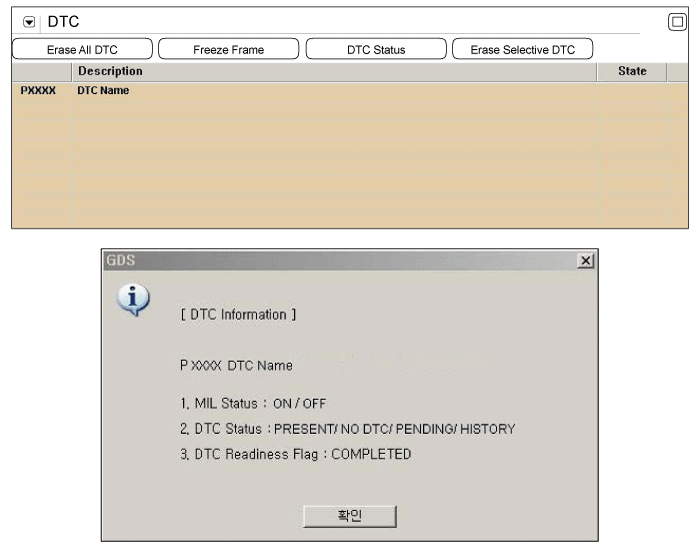
The Camshaft Position
Sensor (CMPS) is a sensor that detects the compression TDC of the NO. 1
cylinder. The CMPS consists of a hall type sensor and a target on the end
of the intake camshaft. When the target triggers the sensor, the sensor
voltage is 5V. If not, the sensor voltage is 0V. These CMPS signal is sent
to the PCM and the PCM uses the CMPS signal for synchronizing the firing
of sequential fuel injectors.
If PCM detects that cam
event signal count is over 3 under detecting condition, PCM sets P0340.
MIL(Malfunction Indication Lamp) turns on.
Item
|
Detecting
Condition
|
Possible cause
|
DTC
Strategy
|
| •
|
Check if CAM sensor is synchronized
correctly | |
|
Enable
Conditions
|
|
Threshold
value
|
| •
|
Cam event signal count ≥
3 | |
Diagnosis
Time
|
|
MIL On
Condition
|
|


This example shows a
typical Crankshaft Position Sensor(CKPS) and Camshaft Position
Sensor(CMPS) waveform at idle. The PCM controls the injection and ignition
timing by using these signals. Generally CKPS signal is used to detect the
piston's position and CMPS signal is used to detect the Top Dead Center of
each cylinder.
| 1. |
Check DTC Status
| (1) |
Connect scantool to Data Link
Connector(DLC). |
| (3) |
Select "DTC" button, and then Press "DTC
Status" to check DTC's information from the DTCs
menu. |
| (4) |
Read "DTC Status"
parameter.

|
| (5) |
Is parameter displayed "Present
fault"?
|

|
▶ Go
to "Terminal and connector inspection"
procedure.
|
|

|
▶
Fault is intermittent caused by poor contact in the
sensor's and/or PCM's connector or was repaired and PCM
memory was not cleared. Thoroughly check connectors for
looseness, poor connection, ending, corrosion,
contamination, deterioration, or damage. Repair or
replace as necessary and go to "Verification of Vehicle
Repair"
procedure.
|
| |
| Terminal And Connector
Inspection |
| 1. |
Many malfunctions in the electrical system are
caused by poor harness and terminal condition. Faults can also be
caused by interference from other electrical systems, and mechanical
or chemical damage. |
| 2. |
Thoroughly check connectors for looseness,
poor connection, bending, corrosion, contamination, deterioration,
or damage. |
| 3. |
Has a problem been found?
|

|
▶ Repair as
necessary and go to "Verification of Vehicle Repair"
procedure
|
|

|
▶ Go to
"Power Circuit Inspection"
procedure.
|
|
■ Check voltage
| 1. |
IG "OFF" and disconnect CMPS(B1)
connector. |
| 3. |
Measure voltage between power terminal of
CMPS(B1) harness connector and chassis ground.
Specification
: Approx. 5V
| |
| 4. |
Is the measured voltage within
specification?
|

|
▶ Go to
"Signal Circuit Inspection" procedure.
|
|

|
▶ Repair
open or short to ground in harness, and go to "Verification of
Vehicle Repair"
procedure.
|
|
| Signal Circuit
Inspection |
■ Check voltage
| 1. |
IG "OFF" and disconnect CMPS(B1)
connector. |
| 3. |
Measure voltage between signal terminal of
CMPS(B1) harness connector and chassis ground.
Specification
: Approx. 5V
| |
| 4. |
Is the measured voltage within
specification?
|

|
▶ Go to
"Component Inspection" as follows.
|
|

|
▶ Go to
"Check open in harness' as
follows.
|
|
■ Check open in harness
| 1. |
IG "OFF" and disconnect CMPS(B1) connector and
PCM connector. |
| 2. |
Measure resistance between signal terminal of
CMPS(B1) harness connector and CMPS(B1) signal terminal of PCM
harness connector.
|
| 3. |
Is the measured resistance within
specification?
|

|
▶ Go to
"Ground Circuit Inspection" procedure.
|
|

|
▶ Repair
open in harness, and go to "Verification of Vehicle Repair"
procedure.
|
|
| Ground Circuit
Inspection |
■ Check open in harness
| 1. |
IG "OFF" and disconnect CMPS(B1) connector and
then IG "ON". |
| 2. |
Measure voltage between signal terminal of
CMPS(B1) harness connector and chassis ground.(Measurement
"A") |
| 3. |
Measure voltage between signal and ground
terminals of CMPS(B1) harness connector.(Measurement
"B")
Specification
: Measurement "A" - Measurement "B" =
Approx. below 200mV
| |
| 4. |
Is the measured voltage within
specification?
|

|
▶ Go to
"Component Inspection" procedure.
|
|

|
▶ Repair
open or contact resistance in harness, and go to "Verification
of Vehicle Repair"
procedure.
|
|
■ Check CMPS
| 1. |
IG "OFF" and connect
scantool. |
| 2. |
ENG "ON" and Measure signal waveform at signal
terminal of CMPS.
Reference signal
waveform :

|
| 3. |
Is the measured signal waveform
normal?
|

|
▶
Substitute with a known - good PCM and check for proper
operation. If the problem is corrected, replace PCM and go to
"Verification of Vehicle Repair" procedure.
|
|

|
▶
Substitute with a known - good CMPS and check for proper
operation. If the problem is corrected, replace CMPS and go to
"Verification of Vehicle Repair"
procedure.
|
|
There is a memory reset function on
scantool that can erase optional parts automatically detected
and memorized by PCM. After testing PCM on the vehicle, use
this function to reuse the PCM on the
others. | |
| Verification Of Vehicle
Repair |
After a repair, it is
essential to verify that the fault has been corrected.
| 1. |
Connect scantool and select "DTC"
button. |
| 2. |
Press "DTC Status" button and confirm that
"DTC Readiness Flag" indicates "Completed". If not, drive the
vehicle within conditions noted in the freeze frame data or enable
conditions |
| 3. |
Read "DTC Status"
parameter |
| 4. |
Is parameter displayed "History(Not Present)
fault"?
|

|
▶ System
performing to specification at this time. Clear the
DTC
|
|

|
▶ Go to the
applicable troubleshooting
procedure.
|
|